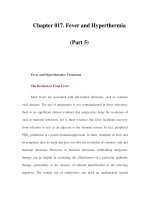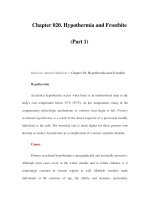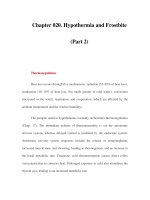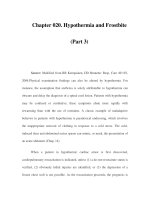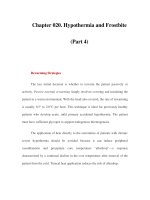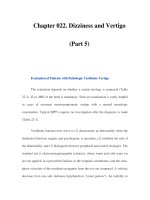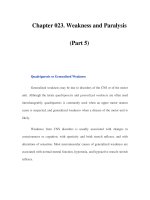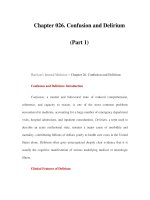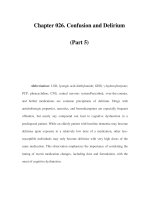Chapter 020. Hypothermia and Frostbite (Part 5) pdf
Bạn đang xem bản rút gọn của tài liệu. Xem và tải ngay bản đầy đủ của tài liệu tại đây (90.25 KB, 5 trang )
Chapter 020. Hypothermia and Frostbite
(Part 5)
Hypothermia: Treatment
When a patient is hypothermic, target organs and the cardiovascular system
respond minimally to most medications. Moreover, cumulative doses can cause
toxicity during rewarming because of increased binding of drugs to proteins, and
impaired metabolism and excretion. As an example, the administration of repeated
doses of digoxin or insulin would be ineffective while the patient is hypothermic,
and the residual drugs are potentially toxic during rewarming.
Achieving a mean arterial pressure of at least 60 mmHg should be an early
objective. If the hypotension does not respond to crystalloid/colloid infusion and
rewarming, low-dose dopamine (2–5 µg/kg per min) support should be
considered. Perfusion of the vasoconstricted cardiovascular system may also be
improved with low-dose IV nitroglycerin.
Atrial arrhythmias should initially be monitored without intervention, as the
ventricular response will be slow, and unless preexistent, most will convert
spontaneously during rewarming. The role of prophylaxis and treatment of
ventricular arrhythmias is problematic. Preexisting ventricular ectopy may be
suppressed by hypothermia and reappear during rewarming. None of the class I
agents has proved to be safe and efficacious. When available, bretylium tosylate
was the class III ventricular antiarrhythmic of choice. There is no evidence that
amiodarone is safe.
Initiating empirical therapy for adrenal insufficiency is usually not
warranted unless there is a history suggesting steroid dependence,
hypoadrenalism, or a failure to rewarm with standard therapy. The administration
of parenteral levothyroxine to euthyroid patients with hypothermia, however, is
potentially hazardous. Because laboratory results can be delayed and confounded
by the presence of the sick euthyroid syndrome (Chap. 335), historic clues or
physical findings suggestive of hypothyroidism should be sought. When
myxedema is the cause of hypothermia, the relaxation phase of the Achilles reflex
is prolonged more than the contraction phase.
Hypothermia obscures most of the symptoms and signs of infection,
notably fever and leukocytosis. Shaking rigors from infection may be mistaken for
shivering. Except in mild cases, extensive cultures and repeated physical
examinations are essential. Unless an infectious source is identified, empirical
antibiotic prophylaxis is most warranted in the elderly, neonates, and
immunocompromised patients.
Preventive measures should be discussed with high-risk individuals, such as
the elderly or people whose work frequently exposes them to extreme cold. The
importance of layered clothing and headgear, adequate shelter, increased caloric
intake, and the avoidance of ethanol should be emphasized, along with access to
rescue services.
Frostbite
Peripheral cold injuries include both freezing and nonfreezing injuries to
tissue. Tissue freezes quickly when in contact with thermal conductors such as
metal or volatile solutions. Other predisposing factors include constrictive clothing
or boots, immobility, or vasoconstrictive medications. Frostbite occurs when the
tissue temperature drops below 0°C. Ice crystal formation subsequently distorts
and destroys the cellular architecture. Once the vascular endothelium is damaged,
stasis progresses rapidly to microvascular thrombosis. After the tissue thaws, there
is progressive dermal ischemia. The microvasculature begins to collapse,
arteriovenous shunting increases tissue pressures, and edema forms. Finally,
thrombosis, ischemia, and superficial necrosis appear. The development of
mummification and demarcation may take weeks to months.
Clinical Presentation
The initial presentation of frostbite can be deceptively benign. The
symptoms always include a sensory deficiency affecting light touch, pain, and
temperature perception. The acral areas and distal extremities are the most
common insensate areas. Some patients complain of a clumsy or "chunk of wood"
sensation in the extremity.Deep frostbitten tissue can appear waxy, mottled,
yellow, or violaceous-white. Favorable presenting signs include some warmth or
sensation with normal color. The injury is often superficial if the subcutaneous
tissue is pliable or if the dermis can be rolled over boney prominences.
Clinically, it is most practical to classify frostbite as superficial or deep.
Superficial does not entail tissue loss. Classically, frostbite is retrospectively
graded like a burn. First-degree frostbite causes only anesthesia and erythema. The
appearance of superficial vesiculation surrounded by edema and erythema is
considered second degree (Fig. 20-1). Hemorrhagic vesicles reflect a serious
injury to the microvasculature and indicate third-degree frostbite. Fourth-degree
injuries damage subcuticular, muscular, and osseous tissues.
Figure 20-1
